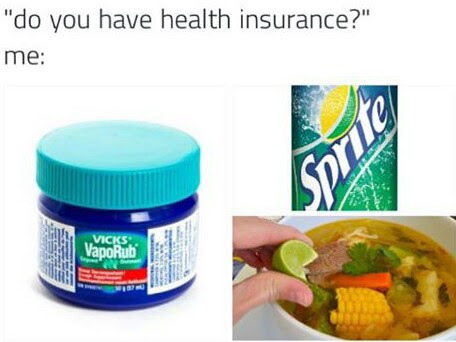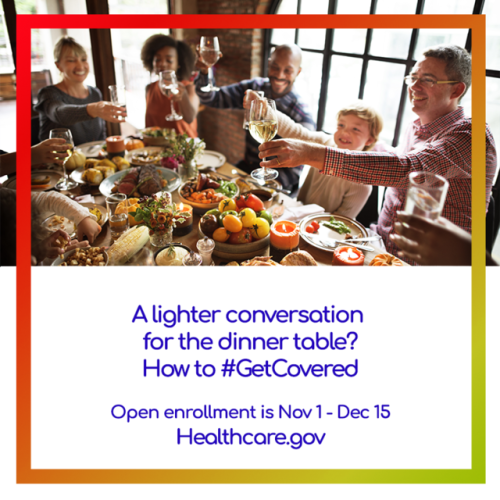#health insurance
Hey Republicans - you want to allow insurance companies to sell across state lines? Not just health insurance, but any category - life, auto, the works?
Fine. Here’s my proposal: companies can sell insurance across state lines, as long as insurance is regulated at the federal level, rather than sate by state, as it it now. Just like securities markets, banking, and almost every other financial service. Except insurance.
Wait, where are you going, Republicans? You lost interest? You mean all this noise about “getting rid of the lines” had nothing to do with creating a more effective and efficient marketplace, and everything to do with setting up a “race to the bottom”, where the states engage in a pathetic competition to weaken the rules so much that they get a to host all the letterbox insurance “headquarters”, and Mississippi wins? Creating at most a hundred or so new jobs in Jackson?
Well, color me shocked.
Open enrollment ends December 15! That means if you need health insurance, you can enroll in a plan through the individual health insurance marketplace, but time is running out.
Even if you already have a plan you like, it’s a great opportunity to shop around and see if you can find a plan that saves you money. 80 percent of shoppers will find a plan for $75 a month or less.
*Go to HealthCare.Gov to sign up for coverage.*
What you need to know to get enrolled:
- The 2018 open enrollment period starts November 1 and ends December 15. That’s right, open enrollment is shorter this year, and the final deadline to enroll in coverage is December 15 for most states. Make a plan to enroll early and avoid the deadline rush!
- New plans and prices are available each year, and plans may be more affordable than you think. 8 in 10 marketplace shoppers can qualify for a plan for $75/month or less.
- Re-enrolling? Shop and save! It’s more important than ever to shop around. You may be eligible for additional savings, so make sure to log into your account, update your information, compare plans and pick the plan that’s right for you.
- Free, local help is available. Use the connector tool above to make an appointment for free in person help enrolling in coverage in your area.
Post link
“Living without coverage can be stressful when you have health concerns, which can agitate symptoms & take its toll. Once I was covered, I had peace of mind.” – Alex Pryor, Young Invincibles
Post link
Believe or not, it’s the 1st of December. Not only does that mean 2017 is wrapping up but there are only TWO WEEKS left to sign up for health insurance. Visit healthcare.gov to shop for plans today! Spread the word~
Post link
Trying to avoid “politics & religion” at the dinner table? An easy conversation is how to #GetCovered. Learn more healthcare.gov
Post link
Memes get old before you know it, and so will you. But young or old, you always need health insurance, because you never know when you’ll need it.
Open enrollment lasts until December 15th. Sign up for health insurance - www.healthcare.gov
Post link
Only 4 weeks left for Open Enrollment! Affordability is no question as health insurance plans can be found for $75 or less per month. Share the links healthcare.gov with friends & family. Now is the time to #GetCovered.
Post link
Open Enrollment has officially started! That means you can now sign up for or switch your health insurance plan. The great news is that 8 in 10 shoppers will be able to find a plan for less than $75/month. Go to healthcare.gov to #GetCovered!
Post link
I got a diagnosis for hypothyroidism. I was very excited to have an answer and that it was something that could be treated easily. Finally it felt like a chance for a normal life, when i felt so sick i felt like i could die. But now my insurance won’t help. I can’t even get coverage to see a PCP. Every doctor they set me up with is someone that cant help me because they’re an ER doctor only or a specialist. The one time they got it right he turned out to be a transphobe and dropped me.
The worst part is the stress this is putting on my boyfriend. We mean the world to each other and though we’ve only been together almost five months, it really feels like hes the one im going to spend the rest of my life with. But its hard seeing me like this, hes mentally ill like me and the stress of taking care of me on top of taking care of himself is more than he’s letting on. He hates when I talk this way but I’ve never seen him cry more than when my symptoms got so bad I couldn’t work. We were both so happy that it was over but as it turns out it isn’t. I really have the worst luck. Everything I do is always like this. I didn’t sign up for this. He certainly didn’t know what he was getting into. I finally found someone who gave me peace, everything finally felt right, and now I can’t even get out of bed, and my heart won’t even beat at a normal rhythm, and im so cold.
its not in my nature to give up, so i won’t, but this is just. very unfair.
Interview with Jeanne Pinder of ClearHealthCosts
Interview by Meg Wachter
Illustration by Amanda Stosz
A month ago on bus ride from New York City to Washington DC I befriended the woman across the aisle from me as we discovered we were both on our way to attend the first ever (in 2016!) White House sponsored: The United State of Women Summit. We were to attend along with 5,000 other women from across the country to discuss economic empowerment, leadership and civic engagement, educational opportunities, violence against women, entrepreneurship and innovation, and health and wellness. It turned out that Jeanne Pinder, a former veteran reporter at The New York Times, falls in the two later categories. She went on from a lifelong career in journalism to creating ClearHealthCosts–a start-up that brings “transparency to the health-care marketplace by telling people prices for medical procedures and items. By revealing prices, we are empowering consumers to make informed decisions about the costs of their medical care and coverage.”
“There’s no easy way to know prices, or to make smart decisions with your money and your health. We’re working to change that.”
Hey Jeanne! Can you tell us a bit about yourself? What’s your background?
I’m a journalist, a believe in full-on transparency. Like all journos, eager to afflict the comfortable, and comfort the afflicted. I’m a native Iowan, living just outside of New York City. Single mom of amazing twin girls, now 22 and just graduated from college.

How long were you a reporter at the New York Times? What led you to a life in journalism? What was/is your favorite thing to cover?
I was born into a newspaper family: My first job, at 13, was as a cub reporter at The Grinnell (Iowa) Herald-Register, a twice-weekly community paper. My dad (who married the boss’s daughter!) was the editor. I grew up there, and worked my way through Grinnell College at the paper.
After earning a BA in Russian, I tried to get out of journalism by going to graduate school in Slavic linguistics, but it didn’t stick and I went back to journalism.
After stints at The Associated PressandThe Des Moines Register, and almost two years living in what was then the Soviet Union, I was hired as an editor at The New York Times.
The Times is a great place to work. I was there for almost 25 years – first, for almost 10 years, as an editor on the Foreign Desk, specializing in Soviet and East European affairs, during the fall of Communism. It was an amazing run of news: The Berlin Wall went down, freedom flowered and then was crushed in Tiananmen Square. The wars in the Middle East, the end of apartheid in South Africa – I got to work with the smartest people in the world on foreign affairs at a time of epochal change.
After that, I was a reporter covering commercial real estate, the deputy founding editor of the Circuits Technology section, the “work-life manager” implementing a policy for flexible and nontraditional work schedules, an editor on the Metro section (during September 11 and its aftermath) and an editor on the lifestyle sections.
I volunteered for a buyout in 2009, and starting in late 2010 I won a series of grants and some angel investment to build ClearHealthCosts, a journalism startup bringing transparency to the health care marketplace by telling people what stuff costs.
I love big, complicated topics. The (then) Soviet Union, technology, nontraditional work arrangements and the crazy opaque health care marketplace.
Why is it important to bring transparency to the American healthcare industry and what was your journey to creating ClearHealthCosts? Was there anything in your life or anything in particular that inspired you to want to start CHC?
People should know what stuff costs. All prices should be clearly available in advance: the price charged, and how much you will pay, and how much others are paying.
That’s what we do at ClearHealthCosts: we find out and post health prices publicly. We use shoe-leather journalism and data diving to find stuff out about pricing and tell people. We also crowdsource health prices with big public media partners like KQED public radio in San Francisco and WLRN public radio in Miami. (Here’s a roundup of our partnerships).
A simple MRI can cost from $300 to $6,221 in the same metro area, depending on provider. But it’s hard to find that information.
Your IUD could cost either $0 or $55 or $2,600. Yes, it’s supposed to be covered by insurance, but …. Well, it’s complicated.
Those birth-control pills could cost from $9 to $63. But how can you know?
The way it works now:
You: “I need an MRI. Here’s the prescription.”
Office person: “Please give me your credit card.”
You: “How much will this cost?”
Office person: “We don’t know.”
You: “Then why would I give you my credit card?”
So, our solution: We’re a mashup of Waze and Kayak for health care prices.
Where you’re able to make a choice – in common, “shoppable” procedures – we give you clear, actionable information, displayed in context.
You might need to know how much an abortion costs, or the price of a colonoscopy.
You might want to know that you can sometimes save money by paying cash – instead of using your insurance card. You might also want to know that there are a number of price transparency tools out there on the interwebs that are not very transparent.
There’s no easy way to know prices, or to make smart decisions with your money and your health. We’re working to change that.
You should be able to easily find out in advance.
It’s a national embarrassment: Our health care system takes advantage of people who are ill, or who don’t have gold-plated insurance, or who don’t have the time to fight through the murk and the bureaucracy and the active attempts to keep you in the dark about prices.
I got interested in this as a journalist because it’s a problem hiding in plain sight: No one can understand their health care bills and insurance company communications.
If it’s this hard to understand, you can bet someone’s making money off the information asymmetry.
As a 33-year-old woman with very bare bones health insurance, I have an extremely high deductible ($6k+) and therefore pay my monthly premium (around $260/mo) in addition to out-of-pocket for any doctor’s visits or procedures. Sometimes I wonder why I have health insurance at all. Why is our system so broken and when did that start?
I feel your pain!
Once upon a time, our insurance system made more sense. It was born of the knowledge that high medical bills can beggar a person, and the need to protect against that.
Our insurance system expanded after World War II, as a result of concern for workers’ welfare and the need to fill jobs, and the system became largely employer-driven for many of us.
This worked pretty well for a while, but then all the nonprofit insurers and other nonprofit market players began to turn into for-profits. This is in some sense a reflection of who we are as a nation – we love us our free enterprise! – but it doesn’t work that well in health care.
If a company is a sleepy, nonprofit hospital or mutual insurance company, it’s more likely to be worried about the welfare of its patients and its insured people.
If it’s a for-profit hospital, insurer, or drug company, answering to shareholders on Wall Street, it’s worried about the stock price. So, obv: if less money is spent on patients, more goes to boosting stock prices, to advertising and executive compensation, to dividends and other things that don’t directly affect the mission of patient care – promoting wellness and treating ill people. Here’s a particularly egregious example about Epipens, though the examples are many.
To be clear, I’m not an opponent of for-profit, free enterprise systems. I used to live in the Soviet Union, and that was an unspeakable mess.
What I think about for-profit, free enterprise health care is that all the prices need to be public, all the time, so I can know what my choices are.
Also: The health care system – like many other systems – is largely built and operated by men, and used primarily by women.
Women own reproductive health, pediatricians’ appointments and elder care. Women nag their spouses, whether those spouses are husbands, wives, or none of the above, to get their health issues taken care of. Men? When we talk about this topic, they often want us to know “no one cares what things cost in health care” or “I haven’t been to a doctor in 12 years” or “doesn’t it all cost $20 or whatever your co-pay is?”
It’s a huge disconnect. As in so many other things, the gender lens and the bias it creates serve to disadvantage women. (I wrote a bunch more about that here.)
What country has the best model of national health care?
Good question: People say that Singapore and Australia have a good blend of private and public, but I have no personal experience of either.
Some of the European social democracies (Denmark, the Netherlands, Sweden) also seem to have a happy solution.
Our system? It’s an international laughingstock: We spend more money and do worse on major measurements of success than any other nation – check out this study and charts. Gah.
What do you hope to achieve with CHC?
People should know what stuff costs.
All prices should be public, all the time: The charged price, your responsibility either as an insured person or a cash patient, what the insurer pays, what the government would pay for the same service.
Our current system is built on half-truths and secrecy. That has to stop.
What women inspire you? Who do you currently admire?
Ah! So many! Here are a few.
Michelle Obama
Hilary Clinton
Ruth Bader Ginsburg
Sonia Sotomayor
Patti Smith
Pussy Riot
Shonda Rhimes
Jen Pahlka at Code for America
Cindy Gallop
Rachel Sklar and Glynnis MacNicol and the #badass Ladies of The Li.st.
Aminatou Sow and Erie Meyer and the #badass women of the TechLady Mafia.
Galina Timchenko at meduza.io
Abbi Jacobson and Ilana Glazer at Broad City
Malala Yousafzai
Helen Mirren
Nancy Lublin at Crisis Text Line
Post link
President Biden Reopened Obamacare Enrollment Due to Coronavirus Pandemic
Biden’s special Obamacare enrollment period opens Monday. Here’s what you need to know
The ACA health insurance marketplace is open! Go to healthcare.gov for more information.
So like if you’re transgender or considering transitioning I would 110% recommend getting a job @ starbucks! I just got off the phone with our HR benefits center & basically the most I’ll have to pay for anything involving transitioning is $5,000! That includes hormone replacement therapy, facial feminization surgery, top surgery, bottom surgery, therapy, laser hair removal, voice therapy & some other shit! With my plan I get 70% coverage w/ a $650 deductible or something like that! Idk I’m just really excited & relieved that I’m not gonna have to make a go fund me or take out any loans or anything like that
Mind you ffs can run you about $40,000 & srs is $23,000 @ the cheapest!

Getting ok and timely medical health insurance has assumed significance like in no way earlier than given the disconcerting upward push in accidents, illnesses, and crucial clinical conditions.
Here are five pointers that will help you choose the satisfactory medical health insurance plan:
Affordability
It is natural to head for a massive fitness cowl at the very beginning. But you have to be realistic, are you able to come up with the money to pay the big top rate? You are possible to your first job and not creating an outstanding deal of cash, so paying the huge premium can be a hassle. Begin with a modest cover and beautify it in step with your desires and earnings degree.
Go cashless
Today cashless fitness regulations are very not unusual and actually are the favored mode for most people. With a cashless policy, no cash is paid out to the sanatorium in case of an operation /scientific emergency. The medical institution gets the go-beforehand from the best medical health insurance business enterprise for the operation and associated methods up to most of the sum confident of the medical health insurance coverage. The policyholder has stored the problem of making payments to the health center and chasing the insurance organization for his cash. Cashless isn’t best hassle-unfastened, it also reduces strain on the policyholder’s finances.
Benefits
Review the advantages at the health insurance plan– for instance check whether or not the coverage has the floater choice – this affords flexibility in phrases of fixing sum confident for individual circle of relatives members in the average ceiling or whether or not it covers ailments and medical situations not unusual within the circle of relatives or whether or not there are exceptions – i.E. Ailments not included by using the coverage and so on.
Free appearance in the period
As a policyholder, you have a proper to return the policy if it is not what you thought it turned into or it simply does now not fit your purpose. According to the law you’ve got 15 days to return the policy after receiving the coverage report. This is known as the ‘unfastened look-in duration’.There are certain situations, however; as an instance, if it’s a medical health insurance coverage then it ought to have a term of at the least three years.
Compare policies online
Since there are numerous coverage agencies providing a health plan and you’re looking for that one coverage first-rate suitable for your desires, it is a great concept to do some homework earlier than choosing the health coverage. For this, examine fitness plans throughout coverage organizations over the net. The top news is every medical insurance employer has an internet presence and most groups make their websites virtually interactive and friendly for visitors seeking on-line rates or even primary plan capabilities.
Today’s topic is health insurance. Take a deep breath, grab some tea… We’ll get through this one together.















